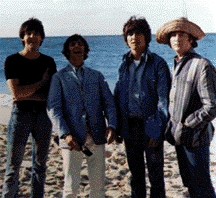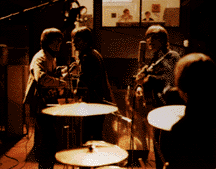



Richard Lester's Help! was the first of a new kind of rock-and-roll movie which altered the shape, face, and form of rock music. Before Help!, most of the rock-and-roll genre movies were simple, self contained films conceived in the narrowest possible terms. In their purest form, they were teen-movies made by people who didn't think much of teenagers. The end result: juvenile melodramas set around the big dance at the local record hop, the starring group's struggle for success, or the search for a new singing phenomenon. The first of such films, Rock Around the Clock (1956), was nothing more than a 74-minute excuse for showcasing the hottest available acts (including Little Richard, Bill Haley & The Comets, and The Platters) in front of the cameras. It also made a small fortune and was followed by some of the most abysmal exploitation films ever to be released on the Big Screen: Don't Knock the Rock (1956), Rock Rock Rock (1957 -- starring a 13-year-old Tuesday Weld), Go, Johnny, Go (1958), and Don't Knock the Twist (1962).

Then, in 1964, along came the Beatles, Richard Lester, and A Hard Day's Night, one of the most finely crafted movies ever made about rock-and-roll, and the tour de force of the film cycle that had begun with Rock Around the Clock. Other filmmakers tried to follow it up, but soon discovered that Lester had left them no place else to go -- A Hard Day's Night became a standard against which its predecessors and imitators could not hide their imperfections.
In planning Help!, Lester him self only had one direction left to look -- outward. In A Hard Day's Night he had presented a band's eye-view of the world as closely as anyone has ever dared. For the follow-up, he focused on the world that had grown around the band: "Swinging London," with its free-spirited, media-generated glow that influenced the state-of-mind and latest fashions of its followers.
Help! was the cinematic embodiment of "Swinging London" and a pop-cultist's dream; an anarchic meld of Hellzapoppin' pacing and Boulting-style satire, with jokes flying from all parts of the script, screen, and soundtrack. The frantically-paced gags referred back to the Bond movies, The Magnificent Seven, Lester's own Running, Jumping, and Standing Still Film and A Hard Day's Night, as well as the BBC's Goon Show, a popular satirical radio program from the 1950s. Even the linking sequences were seasoned with memorable throwaways, including Clang's "Psst -- hey, Beatle." Some were too good to be monopolized by just one film: Ringo's escape from the tiger, perpetrated by all present singing the "Ode to Joy" from "famous Beethoven's famous Ninth Symphony," became the basis for Monty Python's "Mattress Sketch," which used the choral hymn "Jerusalem" to even sillier effect.
The resulting pitch of activity made Help! a very busy film, so much so that John Lennon later complained of feeling like "extras in our own movie." But even amid the chaos, the band had a few chances to poke fun at select English institutions: "They have to paint me red before they chop me," Ringo tells the Scotland Yard superintendent. "It's a different religion from ours -- I think."

The movie's most striking technical attribute was its photography. Help! was an explosion of rich, vibrant color; David Watkin's cinematography made the film look like a pop-art kaleidoscope, swathed in a pre-psychedelic aura. The songs, too, lent themselves to this treatment -- John Lennon's "You've Got to Hide Your Love Away," in particular, was a surreal, Dylan-esque reflection on life and love which became a sounding-board for Lester's fascination with odd camera angles and editing tricks. George Harrison's "I Need You" was a study in irony: an impassioned love song played amid tanks, artillery, and troops. And, best of all, there was "Ticket to Ride" -- a thundering rocker highlighted by Paul McCartney's ferocious Hofner-crunching performance on bass guitar. It was transformed into a conceptual sequence, played to shots of the band skiing in Austria.
The Beatles didn't enjoy making Help! the way they had A Hard Day's Night. But Help! was a flashpoint in a way that A Hard Day's Night had not been. Their frustrations marked a turning point in the band's relationship both with their managers and their "Fab Four" image. Afterwards, the Beatles insisted on running more of their own business affairs and limiting their obligations apart from records. Paul McCartney, in particular, not forgetting the band's experience with Help!, later became the prime mover behind The Magical Mystery Tour (1967), a film directed by all four Beatles and designed to prove that they could do a better job. (They didn't.)
The production coincided with a growing desire on the part of the band members to separate them selves from their collective sound. While working on the soundtrack LP, Paul McCartney became the first Beatle to cut a solo single ("Yesterday," which appeared on the album but not in the movie). John Lennon's "You've Got to Hide Your Love Away" was the first of his ever more expressive array of cryptically inscribed songs, which continued on the Rubber Soul album with "Norwegian Wood," through "I Am the Walrus" and "The Glass Onion," to his early solo albums. And it was while working on Help! that George Harrison discovered a 21-stringed Indian instrument called a sitar. Within a year, he was studying with virtuoso sitarist Ravi Shankar, and it was through Harrison's subsequent compositions that most of the West discovered the star. And Ringo Starr, who'd walked away with most of the comic honors in the band's first two movies, began an acting career highlighted by Joseph McGrath's black comedy The Magic Christian (1969) and Claude Watham's extraordinary homage to early British rock-and-roll, That'll Be the Day (1974).
For the group, however, the individual voices they discovered and the collective freedom they craved after completing Help! began a creative cycle that carried them to their greatest works: Rubber Soul, Revolver, Sergeant Pepper's Lonely Hearts Club Band, The White Album, and all that followed.
-- BRUCE EDER
Credits
Screenplay: Marc Behm, Charles Wood
Story by: Marc Behm
Produced by: Walter Shenson
Directed by: Richard Lester
Director of Photography: David Watkin
Film Editor: John Victor Smith
Art Director: Raymond Simm
Musical Director: Ken Thorne
Special Effects: Cliff Richardson
Make-up: Freddie WilliamsonTransfer
This edition of Help! was transferred from a 35mm archival negative. The soundtrack was mastered digitally from a 35mm magnetic track.

